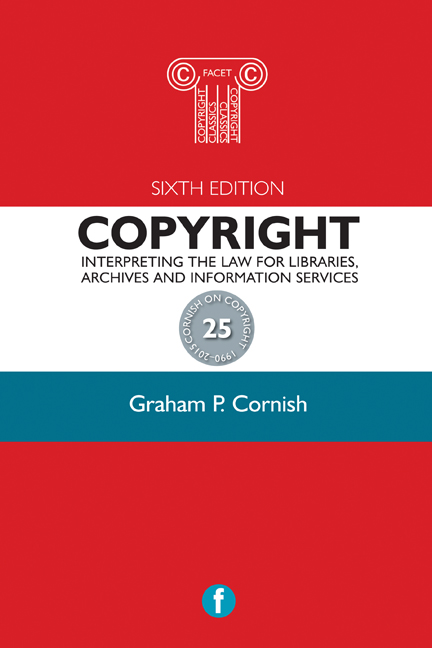Book contents
- Frontmatter
- Contents
- Author's note
- Acknowledgements
- List of abbreviations
- Introduction
- Section 1 Definition and law
- Section 2 What is covered by copyright
- Section 3 Rights and limitations
- Section 4 Literary, dramatic and musical works
- Section 5 Artistic works
- Section 6 Sound recordings and performers’ rights
- Section 7 Films and videos
- Section 8 Broadcasts
- Section 9 Databases
- Section 10 Licensing schemes and licences
- Section 11 Computer programs, the electronic world and websites
- Section 12 Other matters
- Useful addresses and contacts
- Useful sources of information
- Appendix: suggested declaration forms
- Index
Section 2 - What is covered by copyright
Published online by Cambridge University Press: 08 June 2018
- Frontmatter
- Contents
- Author's note
- Acknowledgements
- List of abbreviations
- Introduction
- Section 1 Definition and law
- Section 2 What is covered by copyright
- Section 3 Rights and limitations
- Section 4 Literary, dramatic and musical works
- Section 5 Artistic works
- Section 6 Sound recordings and performers’ rights
- Section 7 Films and videos
- Section 8 Broadcasts
- Section 9 Databases
- Section 10 Licensing schemes and licences
- Section 11 Computer programs, the electronic world and websites
- Section 12 Other matters
- Useful addresses and contacts
- Useful sources of information
- Appendix: suggested declaration forms
- Index
Summary
What things are covered by copyright?
Virtually anything that is written, expressed in graphic form or recorded in any way, or anything that can be made by a human being, but not usually things made by a mechanical process, is capable of being protected by copyright. The law divides these items into various classes and all aspects of them are dealt with separately in the following pages.
Does absolutely anything in these groups qualify for copyright?
No. There are three tests to qualify for copyright and any work must pass all three. They are that the work must be original, recorded and created by a qualifying person.
What does ‘original’ mean?
The law does not say, but the idea is that, to be protected, the author must have contributed quite a lot of their own ideas or skills to the making of the work. Works that are merely trivial will not qualify as they do not demonstrate any originality. Anything that is merely a copy of something that already exists cannot be protected by copyright as a new work.
What constitutes trivial?
This is not defined but a primitive doodle or a simple ‘x’ would not qualify, although what is ‘simple’ and what is not is open to debate!
When does a work based on another work become original?
When sufficient time, effort, technical skills and knowledge have been used to make it reasonably clear the work is a new one and not merely a slavish copy.
Example: If you write your own poem about Jack and Jill, it is protected. If you simply reproduce the well known nursery rhyme with one or two minor changes, the reproduction is not original and not protected – but if you photocopy or scan the poem the typographical arrangement may be protected (see Section 4.88 and following).
What about digitization and the images which it produces?
This is an area where the law is unclear. Generally speaking, it is held that if the work is digitized using a scanner and there is no human intervention (like a photocopy and producing a pdf. file that cannot be manipulated) then there is unlikely to be any new copyright work created.
- Type
- Chapter
- Information
- CopyrightInterpreting the law for Libraries, Archives and Information Services, pp. 7 - 12Publisher: FacetPrint publication year: 2015



